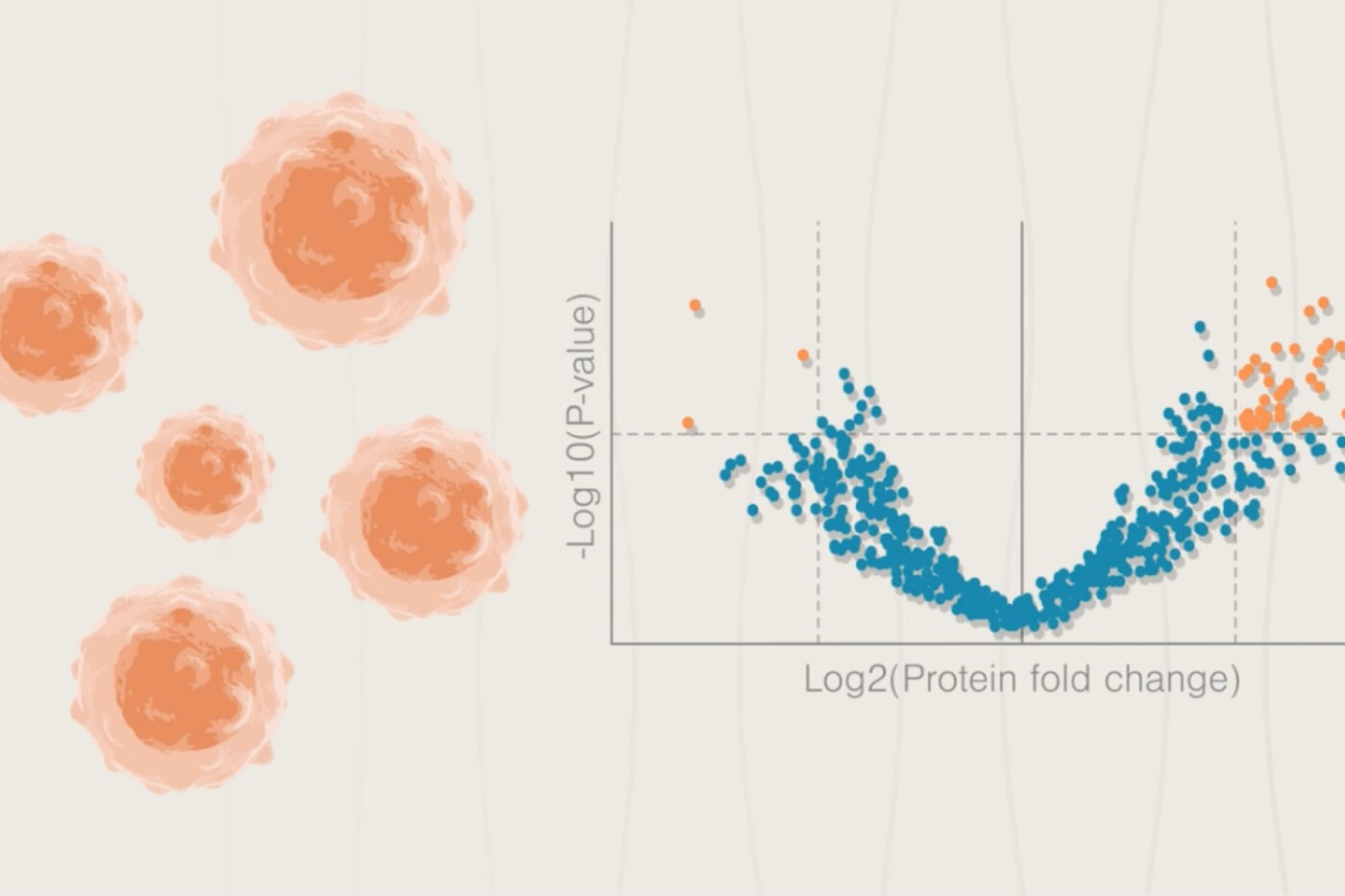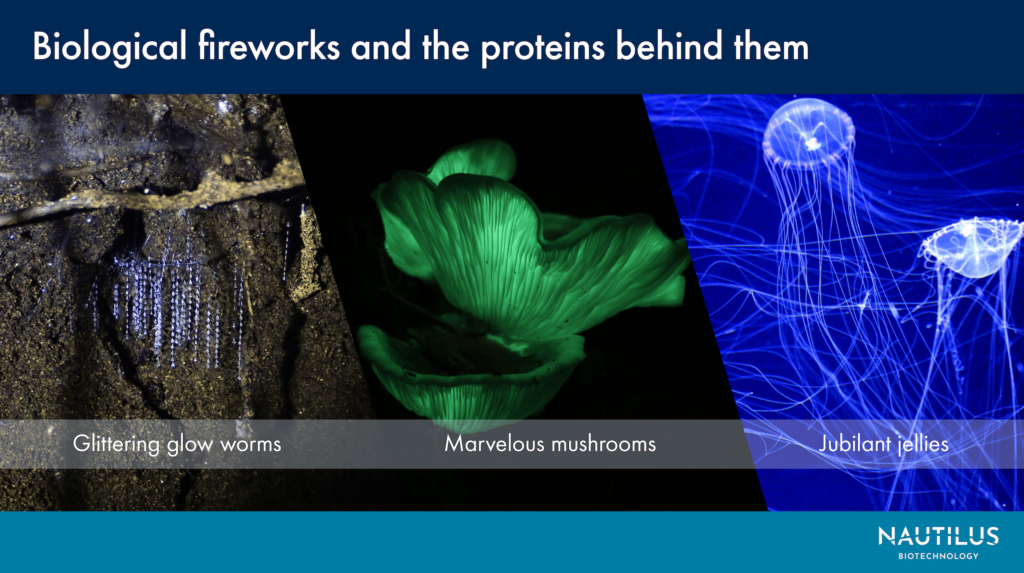
Celebrating the biological fireworks that make the natural world and the lab bright

Tyler Ford
July 3, 2023

In the U.S., the Fourth of July is a time of remembrance, grilled foods, celebration, and above all, fireworks. While man-made fireworks get their characteristic colors and explosive power from mixtures of chemicals, natural displays of light often involve the functions of, you guessed it, proteins!
In celebration of the Fourth of July, we’re covering some of the amazing biological fireworks you can find in nature and the lab. From fungi, to jellyfish, to scientists, light-producing proteins have a ton to offer us all, and we’ll only learn more about them as the proteomics revolution bears fruit.
Hopefully you’ve gotten to see luciferase in action in fireflies or experienced the awesomeness that constitutes bioluminescent algae. However, in this post we’re going to introduce you to some less commonplace examples of biological light production while also highlighting some of the ways biological light has been useful to researchers. We take just a few examples from the land and sea, but we’re only scratching the surface and scientists are likely to discover more as research advances.
A very brief introduction to two prominent forms of biological light production – fluorescence and bioluminescence
When thinking about light-producing proteins, scientists often refer to two kinds:
- Luciferase proteins that work through bioluminescence – These use biological compounds as a source of energy to modify a special metabolite called luciferin. This “excites” the luciferin to a higher energy state and, when it relaxes, it releases the energy in the form of light. Luciferase proteins must work alongside additional proteins that produce luciferin in the first place.
- Fluorescent proteins – Proteins that absorb light at a high energy wavelength and shoot out light at a lower energy wavelength.
With that out of the way, let’s explore how nature and scientists leverage these fascinating proteins.
Lighting the way through the dark forest
- Fantastic fungi
We start with the land where, believe it or not, many fungi (mushrooms in particular) bioluminesce. It is not clear what the function of fungal bioluminescence is, but some research suggests that light production attracts spore dispersing insects that help fungi reproduce. Other studies fail to find evidence for the spore dispersal hypothesis, but the precise reason for bioluminescence in different fungi could be species specific.
Regardless, researchers have identified the biological pathways and genes responsible for some mushroom species’ eerie and mesmerizing glow. They’ve even transferred genes for the production of fungal luciferin and luciferase to plants to effectively generate glowing flowers, tomatoes, and tobacco.
Plants engineered with fungal bioluminescence have practical applications and may help scientists monitor biological pathways. Beyond the practical, you may soon be able to buy your own glowing plants engineered with fungal luciferases. These could be a fun Fourth of July treat and might even rival the appeal of the “rocket’s red glare.”
- Glittering glow worms
The term “glow worm” can refer to several different animals, but, in this post, we’re specifically talking about the larval forms of a gnat from the genus Arachnocampa. These forest and cave-dwelling creatures produce mucus-laden silk “snares” that hang down into the air. Then, the worms themselves bioluminesce to lure prey (insects and other tiny critters) into the snares. Once they’ve snagged something, the worms pull in the snares and gobble up any captured prey.
This appears to be a winning strategy for the glow worms as work in 2011 showed that the production of these luminous lures isn’t particularly costly to the worms. It may therefore constitute an energetically efficient means of getting a meal.
Maintaining glow worm habitats also appears to be a winning strategy for tourism. One popular site in New Zealand attracts hundreds of thousands of visitors a year.
Bright biology of the sea and lab
The ocean is full of various forms of biological light production, but for scientists, jellyfish have become a particularly important source of light-emitting tools. The beautiful Aequorea victoria naturally produces a well-known green fluorescent protein (GFP). Since its discovery, scientists have genetically appended GFP to many other proteins in a wide variety of organisms. Scientists have also engineered GFP variants to produce an array of colors. GFP’s glow enables scientists to monitor protein production and localization in the cell and can help them discern the involvement of a target protein in a wide variety of processes.
Although it has been modified for improved brightness, less aggregation, and higher stability over the years, including with the recent creation of a variant known as “mGreenLantern,” the seminal importance of GFP’s discovery cannot be overstated. It was even awarded a Nobel Prize in 2008.
Not to be outdone, other jellyfish such as Ceratocystis uchidae produce their own fluorescent protein variants. Some of these have beneficial properties when compared to the original GFP. In fact, a GFP from Ceratocystis uchidae was recently engineered for improved stability and the result was so successful that the researchers dubbed their creation, “StayGold.” Their success is a testament to the benefits of looking to nature for new and useful proteins.
Proteomics-powered discoveries of more biological fireworks
Proteomics technologies enable scientists to look broadly at all the proteins produced in an organism while also giving them the ability to study the many ways proteins are modified during their production to achieve an astonishing array of functions. As proteomics technologies advance, researchers will discover more interesting proteins and protein-catalyzed biochemical pathways. Some of these will likely be responsible for vibrant biological displays and, who knows, maybe we’ll discover exploding proteins capable of producing the crowd pleasing BOOMs of fireworks. For the sake of cool science, I hope so. For the sake of fearful pups everywhere, I hope not.
MORE ARTICLES
